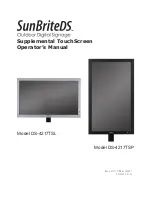
©Sealevel Systems, Inc.
HazPAC R9-8.4 Manual
35
SL9257 8/2015
TARGET DEPLOYMENT AND EXECUTION
After your application is built using Visual Studio, either a debug or release executable, it may be desirable
to copy it into NAND Flash. This would provide a means to store and execute your application without the
need for connectivity to a host computer. The first step is transferring your application to a suitable
directory in the on-board NAND Flash. To accomplish this you will need to establish connectivity via
Windows Mobile Device Center or ActiveSync as outlined in the HazPAC R9-8.4 Quick Start section above.
Figure 23.
Application Placement
The HazPAC R9-8.4 Runtime image comes pre-loaded with a utility program called “SpringBoard”. This
utility provides a solution for automatically running your applications at startup. Rather than copying your
application files to ‘/Windows/Startup/’ – which is in volatile memory – the executables should be copied to
`/nandflash/startup/’. After Windows CE runs, SpringBoard automatically starts applications in this startup
directory.
SpringBoard also provides a way to specify program arguments by supplying an XML configuration file. You
will need to create a simple XML file called “startup.xml”. This XML file should consist of an element list
each with an application name and the desired arguments for that application. (See Figure 24.) This file
must reside in the following location ‘/nandflash/startup/startup.xml’.
If the startup.xml file is not found or is not desired, SpringBoard will still automatically run all the
applications placed in the aforementioned directory structure, only no arguments will be passed to
those applications.
Figure 24
.
startup.xml
<?xml version="1.0" encoding="utf-8" ?>
-
<programs>
<program name="
sample1.exe
" arguments="
/i 1019 /w JSmith
" />
<program name="
sample2.exe
" arguments="-
e
2000
" />
<program name="
sample3.exe
" arguments="
/help
" />
</programs>




































